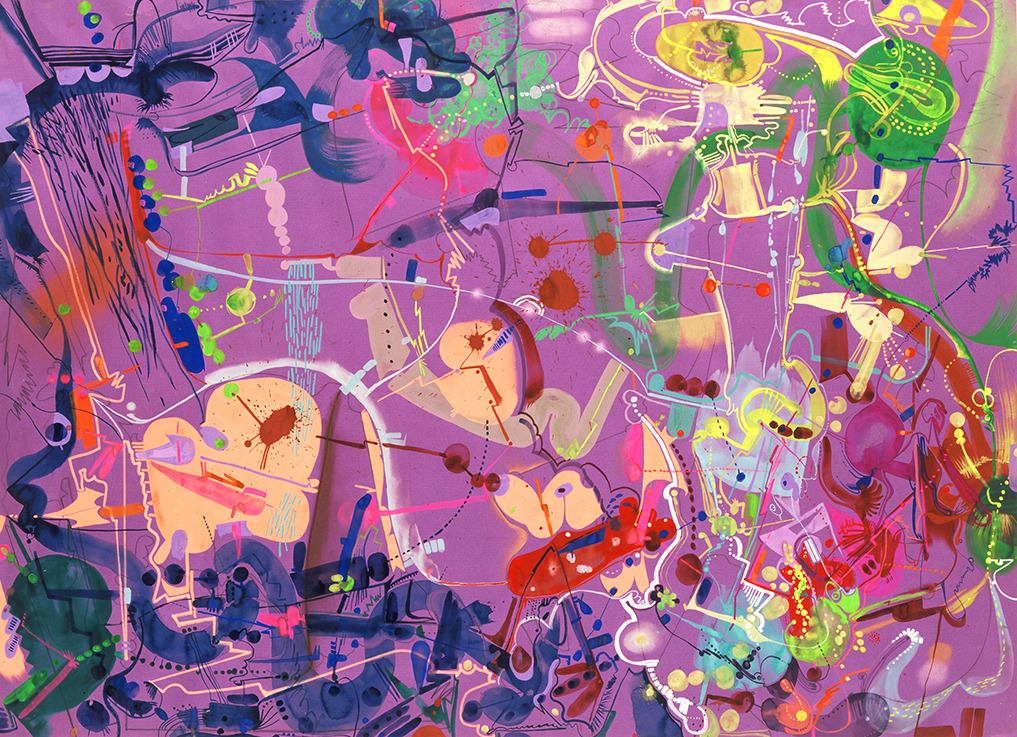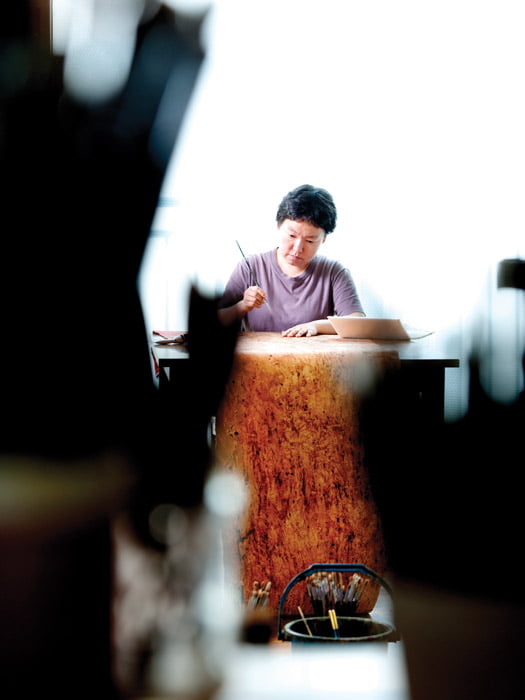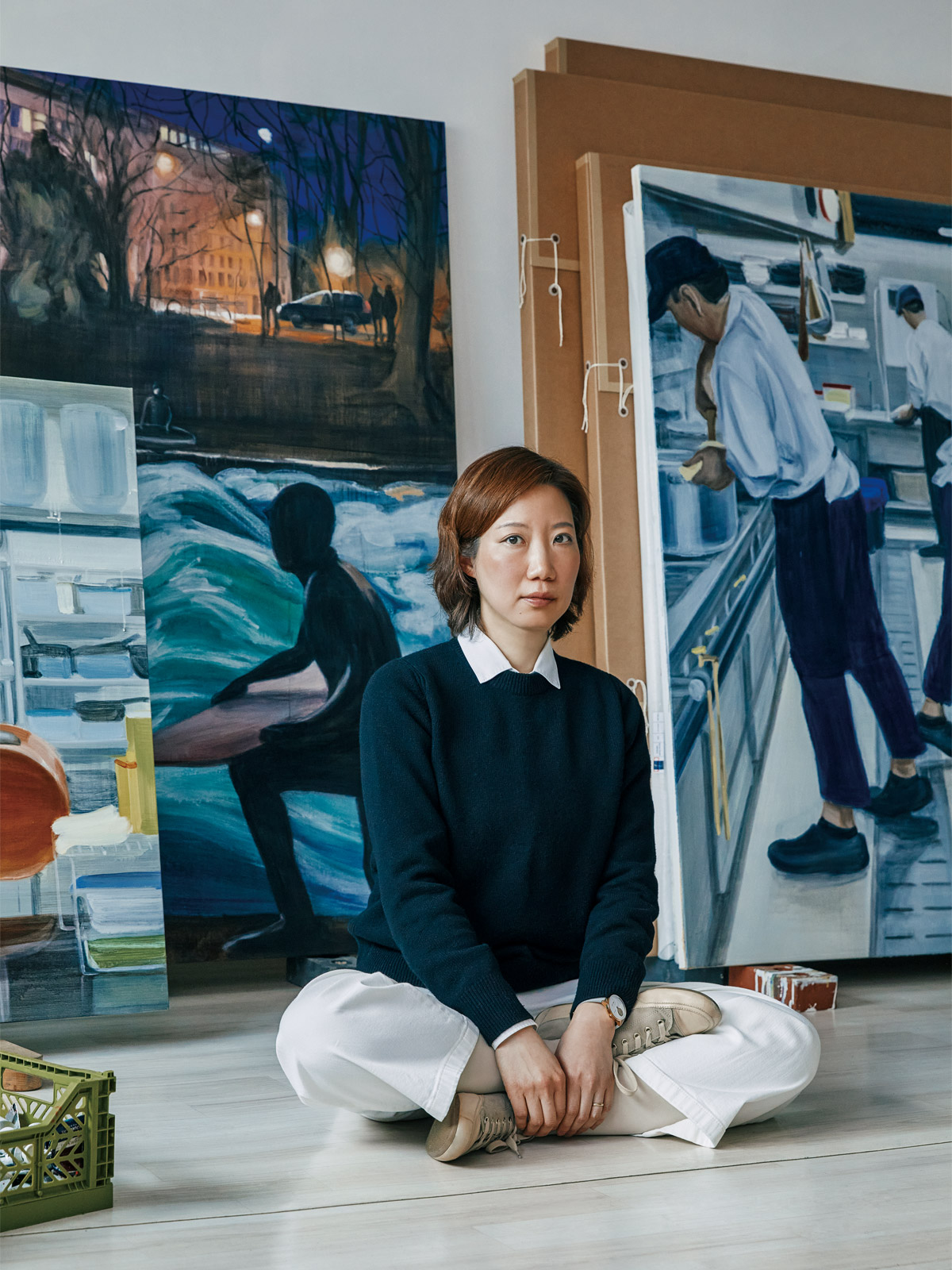Nakhee Sung (b. 1971) has consistently presented organic abstract paintings that convey a rhythm and cadence akin to music, or the dynamic movement of freely flowing colors, through the fundamental elements of painting—points, lines, and planes. These basic expressive elements in her work are intricately interconnected, sometimes reflecting and reacting to one another, crossing paths, or even disconnecting, as they establish complex relationships.
 Nakhee Sung, Untitled,
2006 ©Nakhee Sung
Nakhee Sung, Untitled,
2006 ©Nakhee SungIn Nakhee Sung’s early works, the organic
movement of points, lines, and planes emerges with even greater freedom. These
fluid, intertwined colors amplify the sense of movement in her paintings,
drawing viewers along the flow of these organic color forms and, before long,
into a deeper inner space.
Sung describes her work as “suggestively
visualizing a space for emotion through a simple yet expressive visual
language.” The elements on the canvas build up one by one, dynamically
following the psychological flow within the artist, evolving into a harmonious
and balanced space.
 Nakhee Sung, Frequency,
2006 ©Nakhee Sung
Nakhee Sung, Frequency,
2006 ©Nakhee SungEvery element composing Sung’s canvases proliferates, disassembles, and mutates like individual cells, aligned with the flow of her inner state. This organic process results in a variety of abstract variations. For instance, in Untitled (2006), thin lines and transparent, bold brushstrokes overlap and intertwine, creating layered textures, whereas Frequency (2006) conveys a sense of weight through the interweaving of clean, substantial lines.

Nakhee Sung, Passage, 2006, Installation view at the 1st Singapore Biennale ©Universe in Universe. Photo: Haupt & Binder
Furthermore, Sung’s vibrant colors and
dynamic forms often break free from the flat surface to occupy physical,
three-dimensional space. While drawings on canvas or paper are densely rendered
within confined spaces, wall drawings express her emotions more freely and
spontaneously.
Adapting her work to each exhibition space,
the artist uses paint, markers, and spray to intuitively and expressively
create flowing lines on walls and floors. These expanded, flexible, and
irregular abstract forms surround viewers, leading them to a more sensory and
emotional experience.
 Installation view of
“between you and me” (DOOSAN Art Center, 2010) ©DOOSAN Art Center
Installation view of
“between you and me” (DOOSAN Art Center, 2010) ©DOOSAN Art CenterAlternatively, these wall drawings by Sung can form the very backdrop for her paper drawings, as if the colors and shapes depicted on the small paper drawings have spilled out beyond their frames. This effect generates a more dynamic visual rhythm, creating a sense of continuity and expansion from the paper onto the wall.
 Nakhee Sung, Polyphonic
5, 2016 ©Nakhee Sung
Nakhee Sung, Polyphonic
5, 2016 ©Nakhee SungAdditionally, Nakhee Sung's work often
incorporates musical terms in exhibition titles or artwork names, constructing
her own "composition" on canvas through her chosen materials and
techniques. For instance, the Polyphonic series reflects
polyphony—a style in which independent melodies harmonize across multiple
lines. Likewise, each element on the canvas blends into a harmonious, smooth
ensemble.
Though her process begins with intuitive
sensitivity, it also involves intentional intervention for balance and
cohesion. Sung builds the composition by deliberately adding elements to fill
unbalanced spaces, almost as if scoring music. Yet, these additions are often
spontaneous, leading to diverse variations and interwoven tensions between
individual elements, creating a dynamic push-and-pull effect across the
composition.
 Nakhee Sung, Transpose
1, 2018 ©Nakhee Sung
Nakhee Sung, Transpose
1, 2018 ©Nakhee SungMeanwhile, Nakhee Sung’s recent works prominently feature large color fields, creating a calm and static impression that marks a shift from her previous style. This exploration of a new approach began with the Transpose series, introduced in 2018. The title Transpose, a musical term meaning to shift or change keys, suggests not a variation on existing themes, but rather a search for transformation that opens a new chapter in her artistic journey.
 성낙희, 〈Transpose 11〉, 2018
©성낙희
성낙희, 〈Transpose 11〉, 2018
©성낙희In the early Transpose series, Nakhee Sung’s use of both rigid straight and curved lines stands out prominently. However, as the series progresses, the compositions evolve into more bold, freely divided areas and placements, revealing unexpected color combinations and hints of the artist’s unique wit in the traces of her brushstrokes.
 Nakhee Sung, Sequence
1, 2019 ©Nakhee Sung
Nakhee Sung, Sequence
1, 2019 ©Nakhee SungThe
following year, the Sequence (2019) series builds on this
approach. It appears almost as if fragments of her earlier work are magnified,
with layers of color planes stacking up and connecting in smooth, geometric
forms, resembling digital pixels. Yet, beneath this smoothness lies the dynamic
presence of visible brushstrokes.
The
brushstrokes, blending straight and curved lines, divide the canvas vertically,
horizontally, and diagonally while bending into fluid shapes, creating a
dynamic visual effect. Additionally, the subtle traces of dripping paint and
the deliberately splattered marks introduce a restrained motion, quietly
surfacing within the otherwise static composition.
 Nakhee Sung, Sequence
3, 2019 ©Nakhee Sung
Nakhee Sung, Sequence
3, 2019 ©Nakhee SungIn Nakhee Sung's earlier works, her inner
sensations seemed to radiate outward, engaging in a rhythmic process of filling
and emptying with a sense of balance. However, in the Transpose
and Sequence series, traces of self-reflection appear,
showing a greater spatial and temporal distance than before.
According to the artist, she has recently
been reflecting deeply on gravity during her work. This contemplation is
evident in the Sequence series, where the compositional
elements on the canvas coexist, not by pushing or pulling against each other
with tension, but by an invisible force—similar to gravity—holding them
together in a subtle equilibrium.
 Installation view
of “Modulate” (Perigee Gallery, 2020) ©Perigee Gallery
Installation view
of “Modulate” (Perigee Gallery, 2020) ©Perigee GalleryThus, Sung's recent works appear less
focused on radiating and balancing from within and more on thoughtfully
absorbing the material and immaterial influences around her, brought to
completion through deliberate, slow movement. In this process, each color field
finds its place, linking and layering upon each other, subtly affirming one
another’s presence.
Regarding this shift, Seung Oh Shin, the
director of Perigee Gallery, remarks, “In the end, she brings a non-material
force to her own inner world and delivers her work as an outgrowth of this
process to a condensed scene.”
 Nakhee Sung, Pivot,
2023 ©PIBI Gallery
Nakhee Sung, Pivot,
2023 ©PIBI GalleryIn her recent works showcased in the solo
exhibition “Short Sleeves” at PIBI Gallery, the past 1-2 years of work
prominently feature the use of curves, with an emphasis on organic rhythm and
flow. These recent works combine the contemplative attitude seen in the
2018-2019 pieces with the existing dynamic flow, harmonizing to create a new
rhythmic visual imagery.
As a result, the new pieces are
characterized not by the sense of motion from the release of dynamic energy,
but by smooth and flexible color planes and the natural rhythm emanating from
the forms of free-flowing organic shapes, akin to the quiet, flowing nature of
water.

성낙희, 〈Portamento 31〉, 2024 ©피비갤러리
The titles of the works also evoke a
restrained yet fluid imagery, reminiscent of a leisurely walk. For instance,
the Portamento series, named after the musical technique of
smoothly transitioning from one note to another, captures the smooth and
flexible movement of forms that seem to align with the artist's contemplative
and restrained breath.
Nakhee Sung has created a unique visual
language and visual balance through original variations composed of geometric
elements and sculptural modules, starting from her psychological journey. Like
the forms in her paintings that relate to each other and occupy space fluidly,
her artistic world also continuously evolves, freely engaging with the world.
"This is a visual depiction and representation of my psychological journey. The freely drifting expressions move the viewer's gaze, gradually guiding the heart, eyes, and mind to wander deeply within the space of the painting, following its flow." (Nakhee Sung, Artist's Statement)
 Artist Nakhee Sung
©PIBI Gallery
Artist Nakhee Sung
©PIBI GalleryNakhee Sung has graduated from the Rhode
Island School of Design in the US, and received her M.A. from the Royal College
of Art in London. She has held numerous solo exhibitions at Art Sonje Center,
Doosan Gallery, and more, as well as participating in group show of major art
museums including Ilmin Museum of Art, Modern Art Gallery, Milan, etc. In 2005,
Sung was selected as an artist of the Korean Pavilion Artist at the 51st Venice
Biennale.
She has partaken in residencies in and out
of Korea including MMCA Residency Changdong, Seoul, Doosan Residency Program,
New York, Ssamzie Space Studio Program, Seoul, Cité International des Arts,
Paris, etc., and her works are included in the collections of the National
Museum of Contemporary and Modern Art, Seoul, the Seoul Museum of Art, Seoul,
the Leeum-Samsung Museum of Art, Seoul, LG, Seoul, the UBS Art Collection,
Switzerland, and more.



















